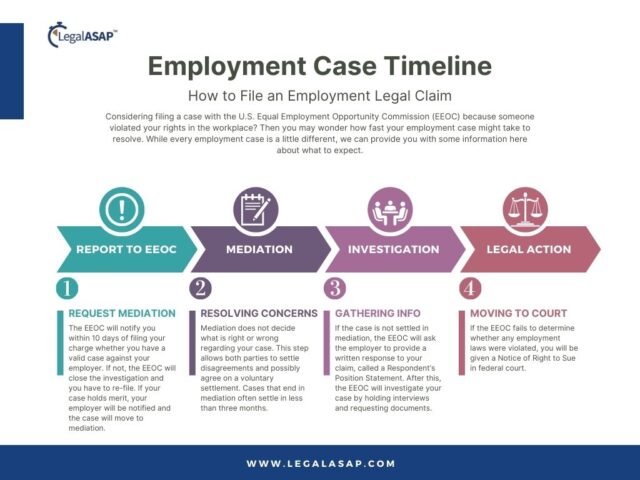Considering filing a case with the U.S. Equal Employment Opportunity Commission (EEOC) because someone violated your rights in the workplace? Then you may wonder how fast your employment case might take to resolve. While every employment case is a little different, we can provide you with some information here about what to expect.
Below is a sample timeline with some additional detail about each step that may happen while pursuing your employment case.
Free Employment Evaluation
Did work violate your employment rights? Click here to speak with a nearby attorney for FREE about your Employment claim.
or call (888)-927-3080

1. The EEOC Notifies Your Employer Within 10 Days of Filing Your Charge & May Request Mediation
At this early stage, the EEOC may determine that your employer broke no laws. If the agency chooses to close its investigation of your claim, it will notify you and that will be the end of your employment case.
If your claim does have merit, the first thing that happens is the EEOC will send a notice of the charge to your employer. In some cases, the agency will ask both you and the employer to take part in its mediation program.
An agency appointed mediator will try to help you and your employer reach a voluntary settlement if you both agree to mediation. During this session, both you and the employer have a chance to talk through your concerns.
Mediators do not decide who is right or wrong regarding your claim. Instead, they suggest ways to solve disagreements that arise between two parties. The EEOC reports that for cases that do go to mediation, a charge is generally settled in less than three months.
2. If Mediation Fails or Isn’t Appropriate, Your Employer Must Submit a Written Statement to the EEOC
The next step in the employment case process is simple. The EEOC usually asks your employer to provide a written answer to your charge. This statement is called the “Respondent’s Position Statement.” Once the agency receives this document, you as the claimant will receive an email. It is available for you to see by logging into the Public Portal at the EEOC website.
Using this same portal, you may upload a response.
This should occur within 20 days from the date you receive your employer’s statement. At this time, the agency may also ask your employer to answer any questions it has about your claim.
3. Once You Respond, the Agency Investigates Your Employment Case
Next, an investigation into your claim will occur. At this point, it has likely been two to three months since you first filed your charge. How the EEOC looks into a charge depends on a variety of factors. An agency representative may visit your employer to conduct interviews. They may need to gather documents. If an employer refuses to cooperate with an EEOC investigation, then it can issue a subpoena. This allows the agency to obtain documents, collect testimony, and gain access to facilities.
After the investigation concludes, the agency will let you and your employer know what they found.
How Long Does an Employment Case Investigation Usually Take?
On average, the EEOC says that it takes approximately 10 months to investigate a charge. Check the status of your charge using EEOC’s Online Charge Status System.
New events may happen after filing your charge that are relevant to your claim. If this occurs, you can amend your charge. In some cases, the agency may ask you to file a new charge of discrimination instead of amending an existing one. The deadlines for filing a charge also apply when you want to amend a charge. Therefore, it is important to contact your investigator immediately if you think other discriminatory events have taken place that are relevant to your ongoing case.
In Most Cases, the EEOC Requires 180 Days to Complete Your Employment Case Review
You must have a Notice of Right to Sue from EEOC before you can file a lawsuit in federal court if you filed your charge under:
- Title VII (discrimination based on race, color, religion, sex and national origin), or
- The Americans with Disabilities Act (ADA) based on disability
In some cases, the EEOC may agree to issue a Notice of Right to Sue before the 180 days is up. However, it generally needs the full six months to review your employment case. There are two exceptions to this rule:
- If you filed your charge under the Age Discrimination in Employment Act (discrimination based on age 40 and above), you do not need a Notice of Right to Sue from the EEOC. Instead, you may file a lawsuit in federal court 60 days after filing your charge.
- If you filed your charge under the Equal Pay Act (wage discrimination based on sex), then you don’t need a Notice of Right to Sue from the EEOC.
How Much Will My Settlement Be?
You could receive a large cash settlement from your employer if your case wins. According to the Society for Human Resources Management, the EEOC “recovered a record $535.4 million in 2020 on behalf of alleged discrimination victims. Litigation recoveries increased from $39.1 million in 2019 to $106 million in 2020.”
Let us connect you with an employment lawyer in our network today to discuss your concerns. It’s the best possible way to know if you may have a case!
Ready to see if you may qualify? Complete your free online employment case evaluation now!
Laura Schaefer
Laura Schaefer is the author ofThe Teashop Girls,The Secret Ingredient, andLittler Women: A Modern Retelling. She is also an active co-author or ghostwriter of several nonfiction books on personal and business development. Laura currently lives in Windermere, Florida with her husband and daughter and works with clients all over the world. Visit her online at lauraschaeferwriter.com and linkedin.com.


